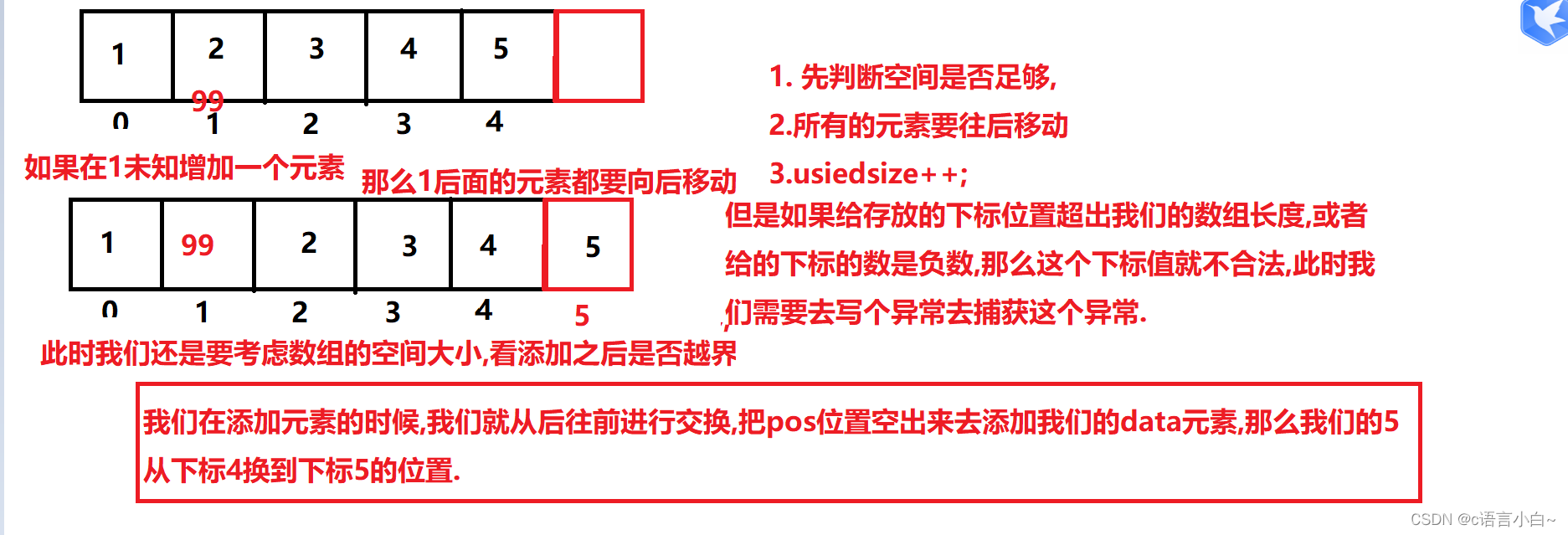目录
1. 顺序表
顺序表是用一段
物理地址连续
的存储单元依次存储数据元素的线性结构,一般情况下采用数组存储。在数组上完成 数据的增删查改。
public class SeqList {
// 打印顺序表
public void display() { }
// 新增元素,默认在数组最后新增
public void add(int data) { }
// 在 pos 位置新增元素
public void add(int pos, int data) { }
// 判定是否包含某个元素
public boolean contains(int toFind) { return true; }
// 查找某个元素对应的位置
public int indexOf(int toFind) { return -1; }
// 获取 pos 位置的元素
public int get(int pos) { return -1; }
// 给 pos 位置的元素设为 value
public void set(int pos, int value) { }
//删除第一次出现的关键字key
public void remove(int toRemove) { }
// 获取顺序表长度
public int size() { return 0; }
// 清空顺序表
public void clear() { }
}那么对于一个顺序表而言,就有上面的几种方法,那么这些方法在我们的顺序表中有已经写好的代码,但是我们具体来讲解以下这些方法的具体实现
1.1 打印顺序表
// 打印顺序表
public void display() {
for (int i = 0; i < usiedsize; i++) {
System.out.println(arr[i]+" ");
}
System.out.println();
}1.2?新增元素,默认在数组最后新增
要分析情况,看看我们的数组空间是否足够

// 新增元素,默认在数组最后新增
public void add(int data) {
if (isFull()) {//如果数组的空间够
this.arr[usiedsize] = data;
}
else {//如果我们的数组的空间不够,那么我们就需要去扩容之后,再去给他存放
this.arr = Arrays.copyOf(this.arr,this.arr.length*2);
this.arr[usiedsize] = data;
}
usiedsize++;
}
public boolean isFull() {
return this.arr.length > usiedsize;
}1.3 在 pos 位置新增元素
public void add(int pos, int data) {
if (isFull()) {//满了就扩容
System.out.println("满了!");
this.arr = Arrays.copyOf(this.arr,this.arr.length*2);
}
//如果没有满那么就需要考虑pos的合法性
if (pos >= this.arr.length || pos < 0) {
System.out.println("pos不合法!");
//不合法我们就去捕捉这个异常
throw new PosWrongfulException("pos位置不合法!");
}
//此时就要进行添加
for (int i = usiedsize; i > pos ; i--) {
this.arr[i] = this.arr[i-1];
}
this.arr[pos] = data;
this.usiedsize++;
}抛出异常
public class PosWrongfulException extends RuntimeException{
public PosWrongfulException() {
}
public PosWrongfulException(String message) {
super(message);
}
}用try catch 语句捕捉这个异常
try {
myArrayList.add(10,10);
}catch (PosWrongfulException e){
e.printStackTrace();
}下面是我们的分析过程:

?1.4 判定是否包含某个元素
这就是一个数组的遍历,看这个数组中是否有这个元素,如果有就返回ture 如果没有就返回false.
public boolean contains(int toFind) {
for (int i = 0; i < this.usiedsize; i++) {
if (arr[i] == toFind){
return true;
}
}
return false;
}1.5?查找某个元素对应的位置
public int indexOf(int toFind) {//如果有就返回下标,没有就返回-1
for (int i = 0; i < this.usiedsize; i++) {
if (arr[i] == toFind){
return i;
}
}
return -1;
}1.6 获取 pos 位置的元素
public int get(int pos) {
if (isNull()){//如果数组是空
throw new EmptyException("数组为空值!");
}
if (pos >= this.arr.length || pos < 0) {//如果pos的位置不合法
System.out.println("pos不合法!");
throw new RuntimeException("get获取元素的时候,pos不合法!");
}
return this.arr[pos];
}抛出异常
public class EmptyException extends RuntimeException{
public EmptyException() {
}
public EmptyException(String message) {
super(message);
}
}
public class PosWrongfulException extends RuntimeException{
public PosWrongfulException() {
}
public PosWrongfulException(String message) {
super(message);
}
}
用try catch 语句捕捉这个异常
try {
myArrayList.add(10,10);
}catch (PosWrongfulException e){
e.printStackTrace();
}
try {
System.out.println(myArrayList.get(1));
}catch (PosWrongfulException e){
e.printStackTrace();
}下面就是我们的分析过程:

1.7?给 pos 位置的元素设为 value
public void set(int pos, int value) {
if (isNull()){//如果数组是空
throw new EmptyException("数组为空值!");
}
if (pos >= this.arr.length || pos < 0) {//如果pos的位置不合法
System.out.println("pos不合法!");
throw new RuntimeException("get获取元素的时候,pos不合法!");
}
this.arr[pos] = value;
}
?1.8?删除第一次出现的关键字key
public void remove(int toRemove) {
if (isNull()){//如果数组是空
throw new EmptyException("数组为空值!");
}
int index = indexOf(toRemove);
if (index == -1){
System.out.println("没有这个元素");
}
for (int i = index; i < usedsize-1; i++) {
this.arr[i] = this.arr[i+1];
}
usedsize --;
}分析过程如下:

?1.9?获取顺序表长度
public int size() {
return this.usedsize;
}?1.10?清空顺序表
public void clear() {
//如果是引用的话,就可以让数组中的所有元素的值变成null
// for (int i = 0; i < usedsize; i++) {
// this.arr[i] = null;
// }
//我们的数组是纯数字的,可以让usedsize变为0,数组就为空了.
this.usedsize = 0;
}